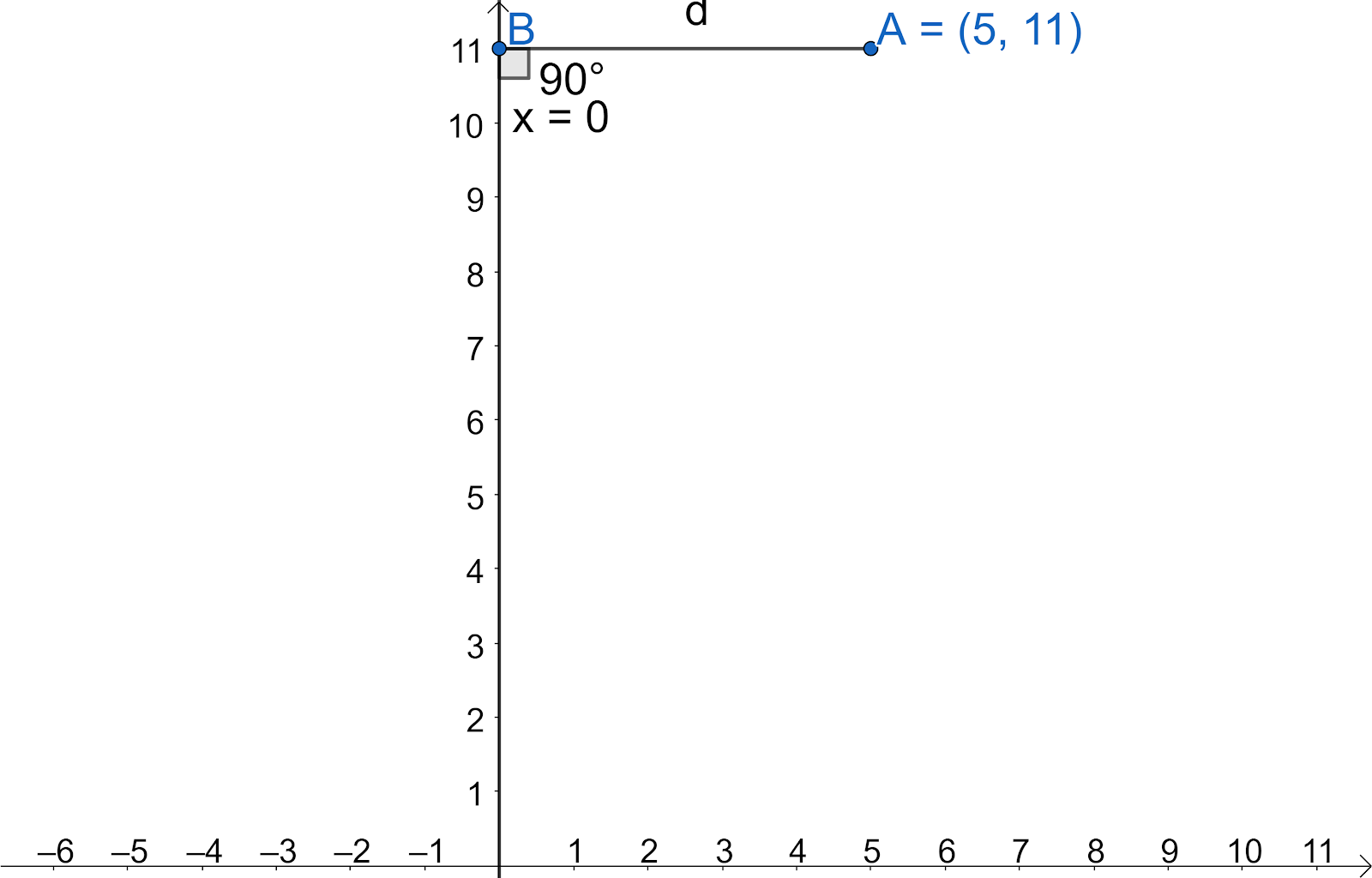
Find the perpendicular distance of the point $A\left( 5,11 \right)$ from the y-axis?
(a) 5
(b) 11
Answer
573k+ views
Hint:We start solving the problem by drawing all the information given in the problem. We then recall the equation of the y-axis and the fact that the perpendicular distance from the point $\left( {{x}_{1}},{{y}_{1}} \right)$ to the line $ax+by+c=0$ is \[\dfrac{\left| a{{x}_{1}}+b{{y}_{1}}+c \right|}{\sqrt{{{a}^{2}}+{{b}^{2}}}}\]. We now substitute the point given and use the equation of the y-axis in the formula. We make necessary calculations to get the desired result.
Complete step by step answer:
According to the problem, we need to find the perpendicular distance of the point $A\left( 5,11 \right)$ from the x-axis.
Let us draw the diagram to represent the situation.

We know that the equation of the y-axis is $x=0$. Let us recall the definition of perpendicular distance between the point and a line.
We know that the perpendicular distance from the point $\left( {{x}_{1}},{{y}_{1}} \right)$ to the line $ax+by+c=0$ is \[\dfrac{\left| a{{x}_{1}}+b{{y}_{1}}+c \right|}{\sqrt{{{a}^{2}}+{{b}^{2}}}}\].
Using this concept, we find the perpendicular between the point $\left( 5,11 \right)$ and the line $x=0$. Let us assume the required perpendicular distance’.
$\Rightarrow d=\dfrac{\left| 5 \right|}{\sqrt{{{1}^{2}}}}$.
$\Rightarrow d=\dfrac{5}{1}$.
$\Rightarrow d=5$.
We have found the distance of the point $\left( 5,11 \right)$ from y-axis as 5 units.
∴ The distance of the point $\left( 5,11 \right)$ from y-axis is 5 units.
The correct option for the given option is (a).
Note:
We should not take negative values for the square root in the denominator while solving this problem, as the distance cannot be negative. We should make sure that whenever we apply modulus to any number, it gives us only a positive number or zero (only if the number is zero). We can alternatively solve the problem by finding the point B which was shown in the figure.
Since, the x-coordinate of the point on y-axis is 0 and we need to perpendicular distance from the point $A\left( 5,11 \right)$, the point B becomes $\left( 0,11 \right)$ as the points A and B lie on the line $y=11$.
We know that the distance two points $\left( {{x}_{1}},{{y}_{1}} \right)$ and $\left( {{x}_{2}},{{y}_{2}} \right)$ is \[\sqrt{{{\left( {{x}_{2}}-{{x}_{1}} \right)}^{2}}+{{\left( {{y}_{2}}-{{y}_{1}} \right)}^{2}}}\].
So, the perpendicular distance is distance between the points $A\left( 5,11 \right)$ and $B\left( 0,11 \right)$.
So, $d=\sqrt{{{\left( 0-5 \right)}^{2}}+{{\left( 11-11 \right)}^{2}}}$.
$\Rightarrow d=\sqrt{{{\left( -5 \right)}^{2}}+{{\left( 0 \right)}^{2}}}$.
$\Rightarrow d=\sqrt{25}$.
$\Rightarrow d=5$ units.
Complete step by step answer:
According to the problem, we need to find the perpendicular distance of the point $A\left( 5,11 \right)$ from the x-axis.
Let us draw the diagram to represent the situation.

We know that the equation of the y-axis is $x=0$. Let us recall the definition of perpendicular distance between the point and a line.
We know that the perpendicular distance from the point $\left( {{x}_{1}},{{y}_{1}} \right)$ to the line $ax+by+c=0$ is \[\dfrac{\left| a{{x}_{1}}+b{{y}_{1}}+c \right|}{\sqrt{{{a}^{2}}+{{b}^{2}}}}\].
Using this concept, we find the perpendicular between the point $\left( 5,11 \right)$ and the line $x=0$. Let us assume the required perpendicular distance’.
$\Rightarrow d=\dfrac{\left| 5 \right|}{\sqrt{{{1}^{2}}}}$.
$\Rightarrow d=\dfrac{5}{1}$.
$\Rightarrow d=5$.
We have found the distance of the point $\left( 5,11 \right)$ from y-axis as 5 units.
∴ The distance of the point $\left( 5,11 \right)$ from y-axis is 5 units.
The correct option for the given option is (a).
Note:
We should not take negative values for the square root in the denominator while solving this problem, as the distance cannot be negative. We should make sure that whenever we apply modulus to any number, it gives us only a positive number or zero (only if the number is zero). We can alternatively solve the problem by finding the point B which was shown in the figure.
Since, the x-coordinate of the point on y-axis is 0 and we need to perpendicular distance from the point $A\left( 5,11 \right)$, the point B becomes $\left( 0,11 \right)$ as the points A and B lie on the line $y=11$.
We know that the distance two points $\left( {{x}_{1}},{{y}_{1}} \right)$ and $\left( {{x}_{2}},{{y}_{2}} \right)$ is \[\sqrt{{{\left( {{x}_{2}}-{{x}_{1}} \right)}^{2}}+{{\left( {{y}_{2}}-{{y}_{1}} \right)}^{2}}}\].
So, the perpendicular distance is distance between the points $A\left( 5,11 \right)$ and $B\left( 0,11 \right)$.
So, $d=\sqrt{{{\left( 0-5 \right)}^{2}}+{{\left( 11-11 \right)}^{2}}}$.
$\Rightarrow d=\sqrt{{{\left( -5 \right)}^{2}}+{{\left( 0 \right)}^{2}}}$.
$\Rightarrow d=\sqrt{25}$.
$\Rightarrow d=5$ units.
Recently Updated Pages
What happens to glucose which enters nephron along class 10 biology CBSE

Write a dialogue with at least ten utterances between class 10 english CBSE

A circle is inscribed in an equilateral triangle and class 10 maths CBSE

When the JanmiKudian Act was passed that granted the class 10 social science CBSE

A sector containing an angle of 120 circ is cut off class 10 maths CBSE

The sum of digits of a two digit number is 13 If t-class-10-maths-ICSE

Trending doubts
The shortest day of the year in India

Why is there a time difference of about 5 hours between class 10 social science CBSE

Write a letter to the principal requesting him to grant class 10 english CBSE

What is the median of the first 10 natural numbers class 10 maths CBSE

The Equation xxx + 2 is Satisfied when x is Equal to Class 10 Maths

What is the missing number in the sequence 259142027 class 10 maths CBSE




